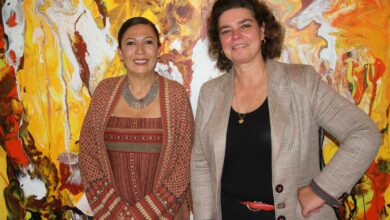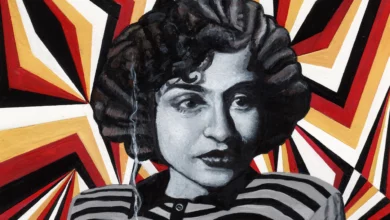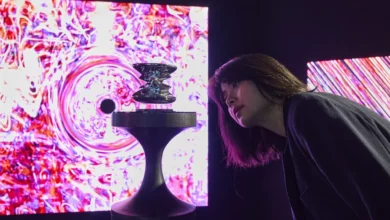In the weeks leading up to the 25 January revolution, a number of large-scale, privately-funded art projects were on the verge of launching. On 22 January, Tache Gallery, part of the Designopolis complex on the Cairo-Alexandria Desert Road, opened with its first show, a retrospective of the work of Egyptian artist Huda Lutfi. Two more examples were real estate developer SODIC's plans for a marble sculpture symposium in February, and Cairo-based art adviser Fatenn Mostafa gearing up to open a new contemporary art space, Cairo Art Initiative, in March.
It was fateful timing, and political unrest in the country has since stalled many large-scale plans, although exhibitions continue to be held at existing spaces. Mostafa has put the Cairo Arts Initiative on hold for the time being and foresees a return to the project only in the distant future. SODIC has postponed their marble sculpture symposium until early fall, though in May they held another sculpture event, in which the choice material was metal.
At Designopolis, a number of arts-related plans have been in the works, including opening up an auction house and a subterranean level called “SoHo” that would offer artists space to display and sell work without gallery representation. But at the moment, this later phase of the complex’s development is on the backburner.
“Our priority now is getting the mall ready. Some things are more important than [the art space], and we decided to just deal with those first,” says Menna Saad al-Din, public relations manager for Designopolis’s parent company Bonyan.
The revolution may have stalled plans for SODIC, Designopolis, and the countless galleries popping up in and around Cairo, but over the past several years there has been a growing surge of private money and support behind arts initiatives in Egypt, where for a long time arts patronage was somewhat monopolized by the state.
“Before the revolution, the arts scene in Egypt was booming. There was an awakening, a renaissance driven by the growing interest in art buying and collecting,” Mostafa tells Al-Masry Al-Youm.
Governments and foundations in the United Arab Emirates have been pouring money into the arts. With the Arab Museum of Modern Art (Mathaf) in Qatar and the future Guggenheim in Abu Dhabi purchasing works by Arab artists, along with projects like the Abraaj Capital Art Prize, the Gulf is leading the way in funding artistic production in the region. The emphasis on cultural funding in the Gulf has helped raise the profile of arts patronage among wealthy Egyptians.
“From watching the Gulf, contemporary art was becoming status,” says William Wells, director of the downtown Townhouse Gallery, describing the growth of arts investment over the past several years.
For this, the recently opened Gallery Misr stands testament. It was founded in May by Mohamed Talaat, who was director of the Palace of Art but defected from the Culture Ministry after the revolution. He is also on contract as SODIC’s art curator for the next two years.
He opened his gallery at a time when many private galleries in Cairo were not holding shows, with Ayyam Gallery even shutting its doors in May, but has nonetheless done reasonably well. The buyers he has seen come from a new crop of investors for whom art is a priority, forming the driving force behind the development of the private art scene in Egypt.
“My customers are young Egyptian collectors, looking for unique, contemporary work,” says Talaat.
The same sentiment was echoed by Omar Ozalp, cofounder of the Articulate Baboon gallery, also in Designopolis, whose gallery seeks to show work that is more youthful and edgy than that found in most commercial galleries in Cairo.
“There is a new generation with money, and they have more forward-looking taste,” Ozalp explains.
But this growing desire to put money into artwork extends beyond collectors and casual buyers purchasing pieces for their private collections and homes. Companies like Designopolis and SODIC, as well as the Ismailia Consortium for Real Estate Investments, a group working on a long term urban renewal project in Downtown, are tapping into a perceived desire for access to urban (or suburban) arts centers.
In the case of Designopolis and SODIC, both development projects far from the center of Cairo and targeting the most wealthy Egyptians, art is seen as an essential part of creating a complete community for a high-end market.
“It’s about good living,” said Nader Lahzi, Managing Director of Bonyan, in a post on Tache Gallery’s website. New York’s Soho neighborhood and the Saifi Village in Beirut were cited as inspirations for the shopping center – one an organically developed urban center, the other a development project like Designopolis, spear-headed by a single company.
At SODIC, art similarly serves the purpose of enriching the lives of the SODIC developments’ residents.
“Art needs to be a part of everyday life,” says Nadine Okasha, marketing manager for SODIC. “It is part of the vision that art be part of the community. SODIC is a part of community development, and it cannot just be about buildings.”
The Ismailia consortium’s project of rejuvenating Cairo’s downtown is a very different kind of development project from Designopolis and SODIC – more Soho than Saifi Village, but with a more mixed target market than either. Chairman of Ismailia Consortium Karim Shafei cites Solidere, the company responsible for Saifi village in Beirut, as an example of the kind of swift and indiscriminate development that Ismailia wants to avoid.
Nonetheless, Ismailia, like Designopolis and SODIC, seeks to serve the demand for a cosmopolitan urban center, where interaction with contemporary art is an integral element.
“The older generation remembers downtown in its glory days,” says Shafei, “but affluent and middle-class society does not come here as much anymore.”
Ismailia seeks to encourage the growth of businesses downtown that will bring people back to the area, and part of its strategy is working with existing arts institutions downtown. They currently own the building occupied by the Contemporary Image Collective, as well as the Townhouse Gallery’s Factory Space. “We bought that space because we want them to stay in there. We have a lot of hopes for that area,” says Shafei.
“Art and culture are non-discriminating activities, and downtown is where all the different segments of society can mix,” he says.
Hoping to attract a diverse crowd through the arts, Ismailia's approach is more nuanced than other private funders, yet concerns over possible gentrification remain among members of the downtown community.
Ismailia has big plans to facilitate the growth of new arts spaces and projects in the future. But their project is intentionally slow-moving, and, like most other large projects, has been further slowed down by continued protests and uncertainty about what the future will look like. Immediate plans for this year were put off until after elections.
Several factors have slowed down what was a fast-growing art scene in Egypt, not the least of which is the fact that many of Egypt’s most wealthy people are under scrutiny for ties to the Mubarak regime. But the current stall could very well be temporary. Talaat is already in talks for a large exhibition of Egyptian and international contemporary art works to take place sometime in the coming year, though funding sources remain in question.
“It is a between time. We cannot see what is in the future, but we cannot stop working,” says Talaat.




